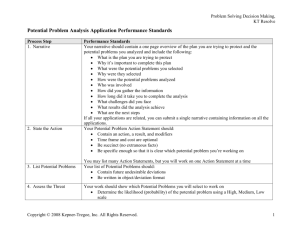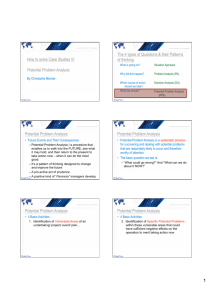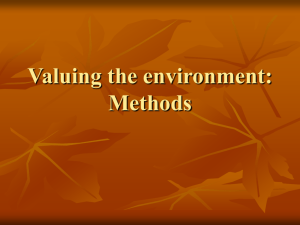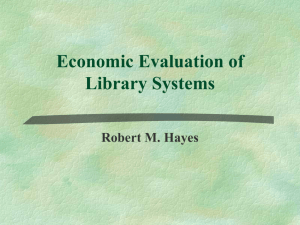USING SURVEYS TO VALUE PUBLIC GOODS THE CONTINGENT
advertisement
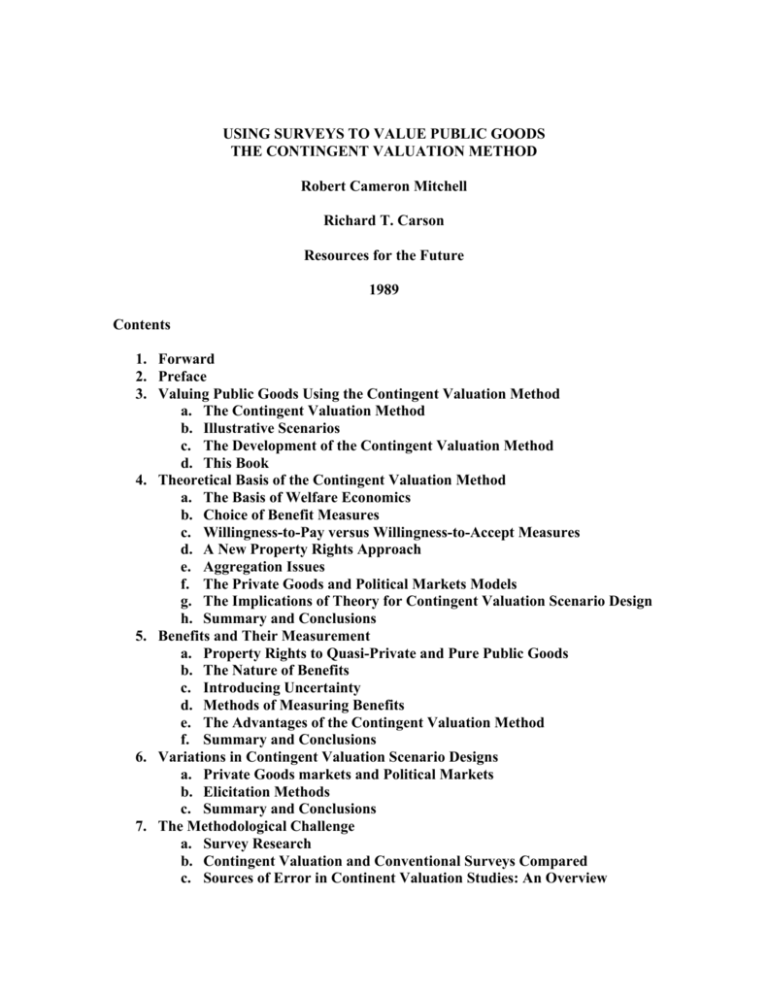
USING SURVEYS TO VALUE PUBLIC GOODS THE CONTINGENT VALUATION METHOD Robert Cameron Mitchell Richard T. Carson Resources for the Future 1989 Contents 1. Forward 2. Preface 3. Valuing Public Goods Using the Contingent Valuation Method a. The Contingent Valuation Method b. Illustrative Scenarios c. The Development of the Contingent Valuation Method d. This Book 4. Theoretical Basis of the Contingent Valuation Method a. The Basis of Welfare Economics b. Choice of Benefit Measures c. Willingness-to-Pay versus Willingness-to-Accept Measures d. A New Property Rights Approach e. Aggregation Issues f. The Private Goods and Political Markets Models g. The Implications of Theory for Contingent Valuation Scenario Design h. Summary and Conclusions 5. Benefits and Their Measurement a. Property Rights to Quasi-Private and Pure Public Goods b. The Nature of Benefits c. Introducing Uncertainty d. Methods of Measuring Benefits e. The Advantages of the Contingent Valuation Method f. Summary and Conclusions 6. Variations in Contingent Valuation Scenario Designs a. Private Goods markets and Political Markets b. Elicitation Methods c. Summary and Conclusions 7. The Methodological Challenge a. Survey Research b. Contingent Valuation and Conventional Surveys Compared c. Sources of Error in Continent Valuation Studies: An Overview d. Summary and Conclusions 8. Will Respondents Answer Honestly? a. Theoretical Developments b. Experimental Results c. Incentive Compatibility in Political Markets d. Summary and Conclusions 9. Strategic Behavior and Contingent Valuation Studies a. Expectations for Strategic Behavior in CV Studies b. Controlling for Strategic Behavior in CV Studies c. Summary and Conclusions 10. Can Respondents Answer Meaningfully a. Hypothetical Data b. Can Hypothetical Studies Predict Behavior c. Summary and Conclusions 11. Hypothetical Values and Contingent Valuation Studies a. Types of Validity b. Content Validity c. Criterion Validity d. Construct Validity e. Summary and Conclusions 12. Enhancing Reliability a. Assessing Reliability b. The Survey Instrument and Reliability c. The Reliability of CV Sample Estimates d. Summary and Conclusion 13. Measurement Bias a. The CV Bias Experiments b. Sources of Systematic Error in CV Studies c. A Bias Typology d. Summary and Conclusions 14. Sampling and Aggregation Issues a. Bias for Sampling Design and Execution Errors b. Inference Biases c. The Fallacy of Motivational Precision: Measuring Benefit Categories and Subcategories d. Summary and Conclusions 15. Conclusion a. Promise of Contingent Valuation b. Relevance and Quality c. Evaluating the Findings of a CV Study d. New Applications 16. Appendix A: Summary of the Content, Form, and Methodologies of Selected Contingent Valuation Studies 17. Appendix B: Survey Instrument for a National Water Benefits Survey 18. Appendix C: Hypothesis Testing and Experimental Design in Contingent Valuation Surveys 19. List of Tables 20. List of Figures 21. Bibliography 22. Name Index 23. Subject Index The book can be obtain from www.rff.org, www.amazon.com, www.barnes&nobles.com, and www.booksamillion.com Parts of the text can be found online at http://books.google.com http://books.google.com/books?hl=en&lr=&id=1R75c1UxVE0C&oi=fnd&pg=PR15 &dq=rt+carson&ots=74Qk4dZedp&sig=g0Q77uOihhLLRk0dT-_wVkvWhUo





